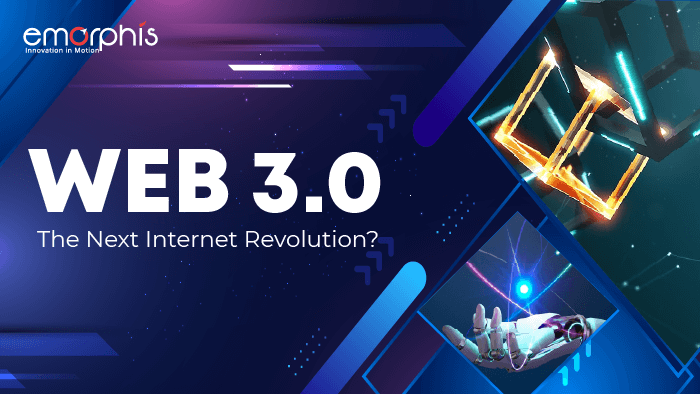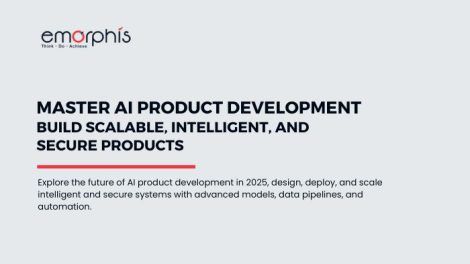Introduction
After the immense popularity of the metaverse, Web 3.0 is the new axiom that has taken the virtual world by storm. It is also known as the decentralized web and is the third version of the internet to take over the current Web 2.0 internet.
With the assistance of Web 2.0, the internet has become more socialized. It helps internet users to remain in contact with others via several social media platforms. However, the major concern with Web 2.0 is that whole control over the data and contents is under a small group of tech giants such as Apple, Microsoft, Meta, Amazon, and Google.
But does it cause any controversy? Yes, in fact, it results in the creation of privacy issues that make users fear losing their freedom over their private (personal, finance, and business) data from the internet services offered by these tech giants.
The arrival of Web 3.0 resulted in the creation of a decentralized version of the internet and thus, gives immense liberty to the internet users to come out from the clutches of the tech giants. Presently, the Web 3.0 model is currently used among private startups to develop social media and financial platforms.
Henceforth, the given article will take the users on an exciting journey of understanding the concept of Web 3.0 that has revolutionized the world of the internet. Further, it will also help them in adjusting their business functioning with the latest technologies to enhance their fortune manifold.
What is Web 3.0?
In short, web 3.0 is the third generation of the internet that focuses on interconnecting data in a decentralized way to offer customers a fast-paced and personalized user experience. It is built on edge computing and uses the latest technology such as blockchain technology, NFTs (non-fungible tokens), and cryptocurrency to focus on:
- Connectivity
- Outreach
- Performance
Moreover, it also comes with three defining characteristics:
- Openness
- Incredible user utility
- Decentralization
It is a semantic web that interprets the concept of data and delivers the most relevant result to the customers. Provided that, the computer behaves just like humans with the help of Artificial Intelligence and Machine Learning to generate useful content to meet the needs of end-users.
Previously during Web 1.0 and Web 2.0, the five tech giants were the ones who made enormous profits from personal data. However, web 3.0 will enable you to get full compensation for your time and data without getting exploited by these tech giants.
What does it signify?
It reveals that users will have the power to sell their data regardless of compromising their data privacy and ownership. Moreover, it also makes your data more meaningful by presenting tailor-made information to the users.
Properties of Web 3.0
Before understanding the nuances of Web 3.0, it will be wise enough to understand its four crucial properties which include:
Property 1: Semantic Web
It is one of the key elements of Web 3.0 that consists of a web of data now processed by a machine. It assists the computer in understanding the meaning of the data to utilize it most fruitfully. Eventually, there is a creation of a spider of knowledge whole over the internet that helps in effective sharing, generating, and connecting content across the internet. So, thanks to it, the semantic web helps in offering better data connectivity among internet users to create a wide pool of data for effective distribution.
Property 2: Artificial Intelligence
In fact, AI is the hottest technology that does not need to be run by humans, it is creating a virtual environment that makes the machine look more intelligent and assists users to satisfy their every mutual need. Also, it assists the website in filtering the users to offer the best data at their service. Moreover, it also helps in providing reliable data from a bunch of unauthentic ones.
Property 3: 3D Graphics
In general, the real change that comes with Web 3.0 in the future is developing 3D cyber words from the simple 2D web. It also has made virtual identities as popular as smartphones have now become. It is still in a nascent phase, but it will rule the cyber world shortly.
Property 4: Ubiquitous
It is the same as being omnipresent, which means the idea of existing everywhere and at the same time. Significantly, the rise of easy availability of the internet and increased usage of smartphones has made connectivity and ubiquity in Web 3.0 more accessible. Another key point, the internet has become more omnipotent, and its fast speed has made connection with other people easy and comfortable.
Examples of Web 3.0 Applications
In real life, several examples of Web 3.0 are already assisting people in numerous areas such as messaging, education, social networking, etc. Here, we are showing several popular Web 3.0 application examples with their widespread scope:
I. Apple’s Siri
There are many speech recognition techniques, and Siri is one of them. With the help of given technology, sharing of information and communication with the customers through personal assistants will offer them better results. Now, users can get results for their every query in the best possible way.
II. Wolfram Alpha
It is a computational intelligence platform that now solely functions in the environment of Web 3.0. The given platform helps the users to compute perfect answers for the fields of science, mathematics, and even nutrition. Moreover, it has better connectivity with other apps to help users get info from their databases and offer accurate results.
III. Sola
It's a decentralized network of social media platforms that runs on the Ethereum blockchain, IPFS, and distributed nodes. It uses blockchain AI to create social networks and hybrids. It assists users, 3rd party developers, through:
- Filtering only good content on the website
- Paying uses their internal virtual currency, called Action points for endorse other’s content
IV. IDEX
It is a well-known decentralized exchange platform that incorporates Web 3.0 to trade ERC-20 tokens through an Ethereum-based wallet. Besides, the users can also practice MetaMask (a cryptocurrency wallet) to get the best user experience.
V. E-Chat
It is a blockchain-based web 3.0 app for offering secure messages across the social network. Using it, users can securely share their data without fearing online theft. It is available easily on App Store and Play Market.
VI. Storj
Do you know the prime feature of Web 3.0? It is the presence of decentralized storage, and Storj helps in utilizing the feature as wisely as possible. It runs on blockchain technology and permits users to rent their disk space free of cost. Besides, it offers a native token for payment on the network that users can earn by renting disk space on the platform easily.

Web 3.0 & Blockchain
Blockchain is the main technology behind Web 3.0 as it is the foundation on which data structures become its backend. In Web 3.0, the Ethereum blockchain deploys intelligent contracts, called smart contracts, that define an application for Web 3.0.
All the data is stored and is accessible globally through a peer-to-peer network. Users can send the file through secure gateways with no need for intermediaries. So, files and data get in an encryption mode to make them fully safe on Web 3.0.
Also, you can read here for Blockchain in Fintech:
https://blogs.emorphis.com/the-blockchain-revolution-in-the-fintech-2/
Web 3.0 & Metaverse
Metaverse is a recent phenomenon and came to the fore when Facebook was recently rechristened as 'Meta.' Though it is still not a reality, but is going to be a new sensation in the world of the internet in the future.
What is metaverse?
It is a shared virtual computer environment that is available through the internet. Web 3.0 plays a crucial role in creating a path to make the metaverse a new reality. How? It will make the virtual world remain in existence online and remain accessible using a web browser.
So, in the coming future, metaverse and Web 3.0 will combine to infiltrate every aspect of society.
Use of Decentralized Apps (dApps): The Door To Web 3.0
Now, after understanding the concept of Web 3.0, it is also important to learn about its working. There needs a change, not externally but internally. It points towards the adoption of blockchain and other high-tech (such as AI and Big Data) to become future-ready.
The answer is the use of dApps that plays an eminent role in bringing blockchain into action. Moreover, with the help of dApps, the utilization of blockchain has increased manifold. By 2027, the global blockchain market is expected to touch the mark of $69.04 billion.
There are certain key aspects of dApps that make them fit for utilization in companies using blockchain technology. These are as follows:
a. Open Source
The main highlight of dApps is it is open source as there is no single entity in control of the app code. Instead, the code of application must remain autonomous and be ready for easy assessment.
b. Incentives
The implementation of dApps points towards the need to generate tokens. They can generate native tokens that act as proof of distribution of the rewards to the customers who gleefully implement Web 3.0 and blockchain technology in their business.
c. Decentralization
There is a major difference between dApps and traditional apps as the former’s backend runs on blockchain technology, and all the operational records are stored on it.
d. Protocol Compliance
The dApps come with a protocol where every stockholder should sign an agreement to get access to the cryptographic algorithm to verify the proof to other players involved in it.
Let's look at some advantages now,
What do dApps offer in terms of value to the customers?
It provides several things:
a) It comes with no downtime
The best part about dApps is that there is no downtime as the network serves the client's needs after the deployment of the smart contract. Besides, it runs on peer to peer system so even if one part of the network ecosystem fails, it will maintain its continuity.
b) Trustless Computation
In contrast to the traditional model, dApps function on a true trustless system devoid of any central authority. It is the smart contract that takes care of every functioning of the given application through blockchain.
c) Privacy
The main advantage of dApps is that there is no demand to reveal the real identity of the users. Instead of going through lengthy signup procedures, users just need to use their digital wallet, log in through Ethereum, and access dApps easily.
d) Data Integrity
It helps in answering the given question; 'What is the use of dApps?' With the use of cryptography, dApps ensure that the data remains secure in the blockchain network storage system. Moreover, accessing public blockchain to view data records by the users is possible through verifying the transaction system.
Final Thought
We are heading to a situation where data will be in full control of people instead of tech giants with total security to their privacy. And all of it will work with the support from blockchain!
With Web 3.0 at the helm, users have the assurance to get transparency and honesty in the usage of personal data. It will include personalized search results with the effective utilization of 3D graphics.
So, it is clear that the internet is becoming more interactive and immersive in nature. So the future belongs to Web 3.0. Let’s embrace the new revolution in the form of Web 3.0 with open arms.







